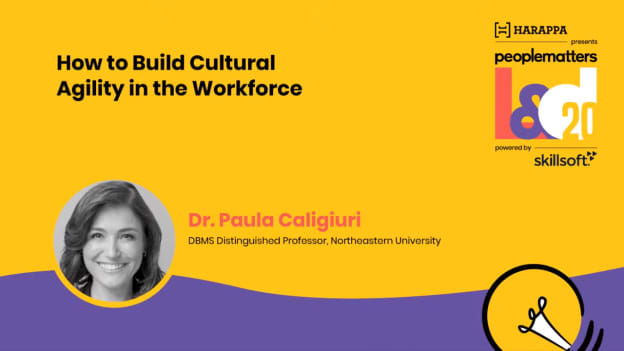Dr. Paula Caligiuri on building cultural agility

Any time we need to establish trust or credibility, communicate effectively, or collaborate with each other in a cross-cultural context, cultural agility is critical, says Dr. Paula Caligiuri, Distinguished Professor of International Business and Strategy at D'Amore-McKim School of Business, Northeastern University. But what actually is cultural agility, and how do we make ourselves culturally agile?
"Cultural agility is the ability for us to interact comfortably and effectively with people from another culture," Dr. Caligiuri defines it simply. Speaking at People Matters L&D Conference 2020, she explained that any of the critical wealth-creating roles in an organization operates across cultural or national borders, there is a very strong chance that cultural agility is one of the most important competencies in that role.
The skills that make someone culturally agile include: global or cultural fluency, integrating oneself into a foreign environment, intercultural communication, and leading across countries and cultures. However, Dr. Caligiuri points out that these are also the skills people are least likely to possess—simply because humans are wired to make split-second judgements, and when we encounter a person or situation that is unfamiliar, we automatically use stereotypes to make those judgements.
"We make judgements about people all the time, before we consciously process what's happening. This is so fundamental to cultural agility because it permeates everything we do," she says.
Before, throughout, and after training: assess
Most organizations attempt to develop cultural agility by sending people for training in cross-cultural awareness—for example how to deliver a speech so that it will be well received in another culture—or by providing people with cross-cultural experiences by assigning them to a global project or seconding them to a global team. But there's a key connection missing there, according to Dr. Caligiuli.
"The real link is assessment. What we found in our research is that for training and development to be most effective, we need to understand an individual's baseline for their cross-cultural competencies. In other words, we need to give them what they're ready for," she says.
"If you assess well, and understand what an individual is ready for, your training programs will work beautifully."
Dr. Caligiuli and her colleagues have identified three major buckets of cultural competencies that can be assessed for, which she shared:
-
Self-management: the ability to linger for longer in an unfamiliar context, and navigate it prior to using any judgement. It involves qualities such as tolerance of ambiguity, resilience, and curiosity.
-
Relationship management: involving skills and qualities such as perspective-taking, humility, and relationship-building.
-
Task management: this involves highly task-centric abilities such as cultural minimization, cultural adaptation, or cultural integration, each of which is applied to different roles and for different purposes.
Task management competencies are particularly complex, says Dr. Caligiuli, because they are highly task-dependent. Cultural minimization, for example, is required in roles and situations where it is necessary to impose a standard onto a different context, such as quality control. Cultural adaptation is about becoming acceptable to the culture, which might be required in sales and marketing roles. And cultural integration involves finding a central path, creating a set of norms that is special to the particular group.
"Leaders need to have all three [task management competencies]—the most culturally agile leaders are able to toggle across these three with ease," she says. "If we start there, understanding your bench strength for how culturally agile your leadership team and your critical roles are, that is such an important first step, because then training and development knows what to create."
Importantly, she points out, many cultural training programs focus on training people in behavioral norms, but that is only the tip of the iceberg. The training needs to help people delve deeper below the behavior, and understand the beliefs and values of the people they will interact with.
"Developing cultural agility is not physically breathing the air of another country for some amount of time. Developing cultural agility is not the number of passport stamps or frequent flyer miles that you have. Developing cultural agility is not visiting various offices around the world as an outsider."
Instead, Dr. Caligiuli's advice is to stretch in cultural novelty according to a person's baseline, to ensure contextual understanding is provided, and to make sure that the person has plenty of opportunities for social learning. And all this should begin with assessment, the critical link: with a correct assessment of their current ability and capacity, the right level of developmental experiences can be crafted for them and help them develop the next level of cross-cultural competencies.














